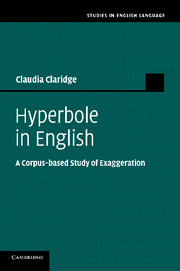Book contents
- Frontmatter
- Contents
- List of figures
- List of tables
- Acknowledgements
- 1 Introduction
- 2 The characteristics of hyperbole
- 3 Realisations of hyperbole
- 4 Using hyperbole: the speaker perspective
- 5 Hyperbole in interaction
- 6 Conventionalisation
- 7 The rhetoric of hyperbole
- Conclusion
- Appendix 1 Modern corpora used (Chapters 1, 2, 3, 4, 5 and 6)
- Appendix 2 Modern sources other than corpora (Chapters 2, 3, 4 and 5)
- Appendix 3 Conventionalisation in dictionaries (Chapter 6)
- Appendix 4 Corpora, dictionaries and texts used for the diachronic investigation (Chapter 6)
- Appendix 5 Sources used in Chapter 7
- References
- Index
5 - Hyperbole in interaction
Published online by Cambridge University Press: 04 February 2011
- Frontmatter
- Contents
- List of figures
- List of tables
- Acknowledgements
- 1 Introduction
- 2 The characteristics of hyperbole
- 3 Realisations of hyperbole
- 4 Using hyperbole: the speaker perspective
- 5 Hyperbole in interaction
- 6 Conventionalisation
- 7 The rhetoric of hyperbole
- Conclusion
- Appendix 1 Modern corpora used (Chapters 1, 2, 3, 4, 5 and 6)
- Appendix 2 Modern sources other than corpora (Chapters 2, 3, 4 and 5)
- Appendix 3 Conventionalisation in dictionaries (Chapter 6)
- Appendix 4 Corpora, dictionaries and texts used for the diachronic investigation (Chapter 6)
- Appendix 5 Sources used in Chapter 7
- References
- Index
Summary
While the preceding chapter focused on the speaker, the present chapter will stress the interactive nature of hyperbole more than was done previously and thus will also pay greater attention to the role of the hearer. I will first deal with the question of how addressees understand hyperbolic utterances, discussing various approaches to the processing of figurative language. Then I will proceed to present the addressee's explicit reactions to hyperbole that can be seen as a correlate to the speakers' self-references treated in Chapter 4, and the staging of hyperbolic exchanges. This point will also include a brief look at the role of hyperbole in ritual insulting and boasting behaviour. Finally, I will discuss how hyperbole can function within the context of face-work and politeness.
Understanding hyperbole
Let me start by some brief remarks about ‘understanding’. I assume that there is no complete understanding, that is, no absolute identity of what is meant and what is understood. Instead, there is far-reaching but nevertheless still approximative understanding, due to the fact that the knowledge systems of speakers overlap partly but not entirely. Communication works as it does because there is a mutual presumption of understanding, which is upheld as long as there is no clear evidence to the contrary in a given communication situation. In such cases understanding and misunderstanding will then become the focus of negotiation.
- Type
- Chapter
- Information
- Hyperbole in EnglishA Corpus-based Study of Exaggeration, pp. 130 - 169Publisher: Cambridge University PressPrint publication year: 2010
- 1
- Cited by



